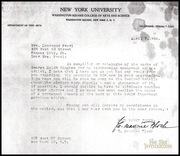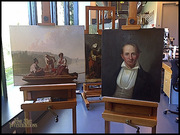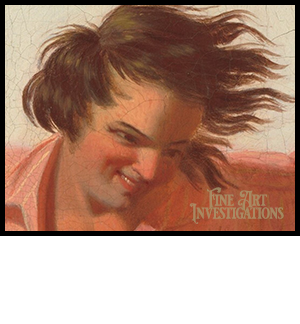
Oil on Canvas, 30 inches x 25 inches
Private Collection
In the mid-1940s, as art historian E. Maurice Bloch researched paintings of George Caleb Bingham, he twice wrote the owner of the portrait John. A. Trigg (1811-1872). Bloch knew that Trigg’s first wife was the artist’s first cousin, Rebecca Bingham (1821-after 1850). He knew that the couple lived in Missouri, in Blackwater Township, not far from the home of the artist and his first wife, Elizabeth, in Arrow Rock. Bloch knew of the portrait, too, from notes now lost.[1] In the years before computers and the Internet, Bloch had no way of easily knowing that he had written the portrait owner at a very bad time. Between March 1944 and October 1946 she had lost a husband to heart failure, re-married, and lost her second husband to a stroke.((Researcher Julia Totten-Armstrong, former librarian at the Huntington Library and provenance specialist, searched pertinent files in the E. Maurice Bloch papers at the Getty Research Institute but could not documentation suggested in the existing 1846 letter from Bloch.)) In a second letter that Bloch sent on April 7, 1946, he wrote:
I should dislike to have to eliminate mention of your picture and I am sure you must realize the value of a permanent record of the work of this truly important American artist.
Again, she did not reply and, true to his word, Bloch eliminated any mention of the portrait of John A. Trigg in his monograph, which evolved into his George Caleb Bingham Catalogue Raisonnés.

April 7, 1946
Eventually, the portrait descended within the family to the current owner who did indeed recognize the value of a permanent record of the work of “this truly important American artist.” In 2010, she contacted Fine Art Investigations.
Date
Following an approach based on the merger of scientific method and connoisseurship, Fine Art Investigations first determines when the artwork was created.. The length and rounded cut of the subject’s shirt indicated the portrait was painted in the mid-1840s. The attire can be found in portraits of that time throughout the nation, and in the George Caleb Bingham portraits of Judge William Barclay Napton and Dr. John Sappington, both painted in Arrow Rock, Missouri, in 1844.

George Caleb Bingham, Judge William Barclay Napton,1844/1845
Oil on Canvas, 30 x 25 inchesPrivate Collection
George Caleb Bingham, John A. Trigg, ca. 1844 
George Caleb Bingham, Dr John Sappington, 1844
Oil on Canvas, 35 x 27 inchesNelson-Atkins Museum of Art Kansas City, Missouri
Based on the life of the subject, John A. Trigg, the next question of “where” was already answered: Blackwater Township or Arrow Rock, Missouri.
Subject
Virginia-born John A. Trigg is remembered as one of the strongest of Union supporters in Missouri during the Civil War. Copies of Trigg’s last will and testament still circulate as an example of a family torn apart by the conflict.((State Board of Health of Missouri, Standard Certificate of Death for Pearl, Laurence Theodore, State File #10057, filed April 6, 1944; State Board of Health of Missouri, Missouri Marriage License Application 3444, for Charles Richard oOrth and Lucille Blanche Pearl, April 11, 1945; Standard Certificate of Death for Pearl, Laurence Theodore, State File #10057, filed April 6, 1944 State Board of Health of Missouri, Standard Certificate of Death for North, Charles, Richard, State File #10057, filed April 6, 1944.))
Trigg was an attorney and farmer in Blackwater Township, Saline County, Missouri, and in Cooper County, Missouri. Son of William Trigg and Sarah Theodosia Anthony. John came to Missouri with his family in 1830 at the age of 15. After passing the bar, he bought land outside Arrow Rock, Missouri. Trigg married George Caleb Bingham’s youngest cousin, Rebecca, about 1835. In 1836, Trigg was elected Saline County Clerk and Recorder – a position he held for 12 years.
Trigg caught gold fever in 1849 and left his family for California. He came home after a year and planned to return with his family, only to learn that Rebecca had died. With five motherless children, in 1852 he married another Bingham cousin, Amanda Harette Harvey. He and Amanda had two children together. He never returned to California.
During the Civil War, two of Trigg’s sons from his first marriage supported the Confederacy. He legally disinherited both.
Saline County voters re-elected Trigg to his earlier position of Saline County Circuit Court Clerk in 1870. He died March 4, 1872 at the age of 57.
On a visit to Austin, Texas, in 1873, George Caleb Bingham looked up one of the sons of John and Rebecca Trigg. He wrote his sister Amanda Bingham Barnes, “I have seen Bingham Trigg. He is doing well here.” Bingham biographer Paul C. Nagel, author of George Caleb Bingham: Missouri’s Famed Painter and Forgotten Politician (University of Missouri Press, 2005), when I asked, wrote “From my knowledge of Bingham, I’m confident that he was a chum of Trigg—their passionate Unionism alone would account for it.”((
Transcription of the Will of John A. Trigg, dated September 25, 1865, from the personal files of the portrait owner:
In the name of God, Amen, I, John A Trigg of Cooper County, Missouri, being of sound mind and memory but admonished by my failing health, that I am liable at almost any time to die suddenly and at most can live but a few years, do therefore make this last will and testament. And in the first place I desire the payment of all my just debts.Secondly, I give my wife Amanda J Trigg after my debts are paid one third of my real and personal estate absolutely. Third, I give to my son Abram Trigg, $500. Fourthly, to my daughter Mary R Wallace, I give the sum of $400, but her husband has been a rebel against this government, I desire that this small amount shall be invested and so managed that my said daughter shall alone receive the benefit of it during their joint lives, and in no event to be subject to the payment of his debts. Fifthly, I give to my daughter in law Mary Frances the wife of my son William the sum of $200, this sum is to be subject to her own control and management.
Sixthly, as all the children of my first wife inherited from their grandfather Wyatt Bingham a right pretty estate, and which like all other fools they have done all in their power to destroy by the acts of treason and disloyalty to their Government (the best ever established among men) and for the further reason that my three oldest sons, William, Bingham and John have been willfully disobedient and unmindful of my best counsel and advice and have sought and followed the advice and counsel of evil, wicked and traitorously affected persons and they thereby destroyed more than half of my estate, I do therefore and for these reasons, give to said sons William and John each the sum of $1.00 and to Bingham the sum of 10 cents, which is all I intend for them to have of my estate.
Seventhly, I give to my daughter Dotia Ann and my son Abner each one third of the remainder of my estate with my blessings and prayers, that they may increase it honestly and use it wisely and that they may never in their bosoms give shelter to a single thought at war with the union of the states.
Eighthly, I have one request to make to those who may have the disposition of my body, after death, I have long observed with pain and regret the pride and pomp displayed on funeral occasions, sometimes almost to the impoverishment of the living, I want none of it, but direct that my body be interred in the cheapest, plainest and quietest way, let a plain block of native marble, limestone mark the spot with my name out on it and the words “He loved his whole Country” and lastly I have hereby constituted by wife Amanda H. Trigg executrix of my last will and testament.
In Testimony whereof I have hereunto subscribed my name, and affixed my seal this 25th day of Sept. 1865))
Discussion
Trigg was enough of an eccentric and a friend to be the perfect subject for Bingham to experiment with a more casual portrait style. The artist painted Trigg with a slight head tilt and with windblown hair. Was the portrait the precursor for Bingham’s flatboatmen?
Verification
After consensus by several Bingham scholars throughout the country, conservators at the Fine Arts Museum of San Francisco examined the portrait and found it not inconsistent with their works by George Caleb Bingham.




